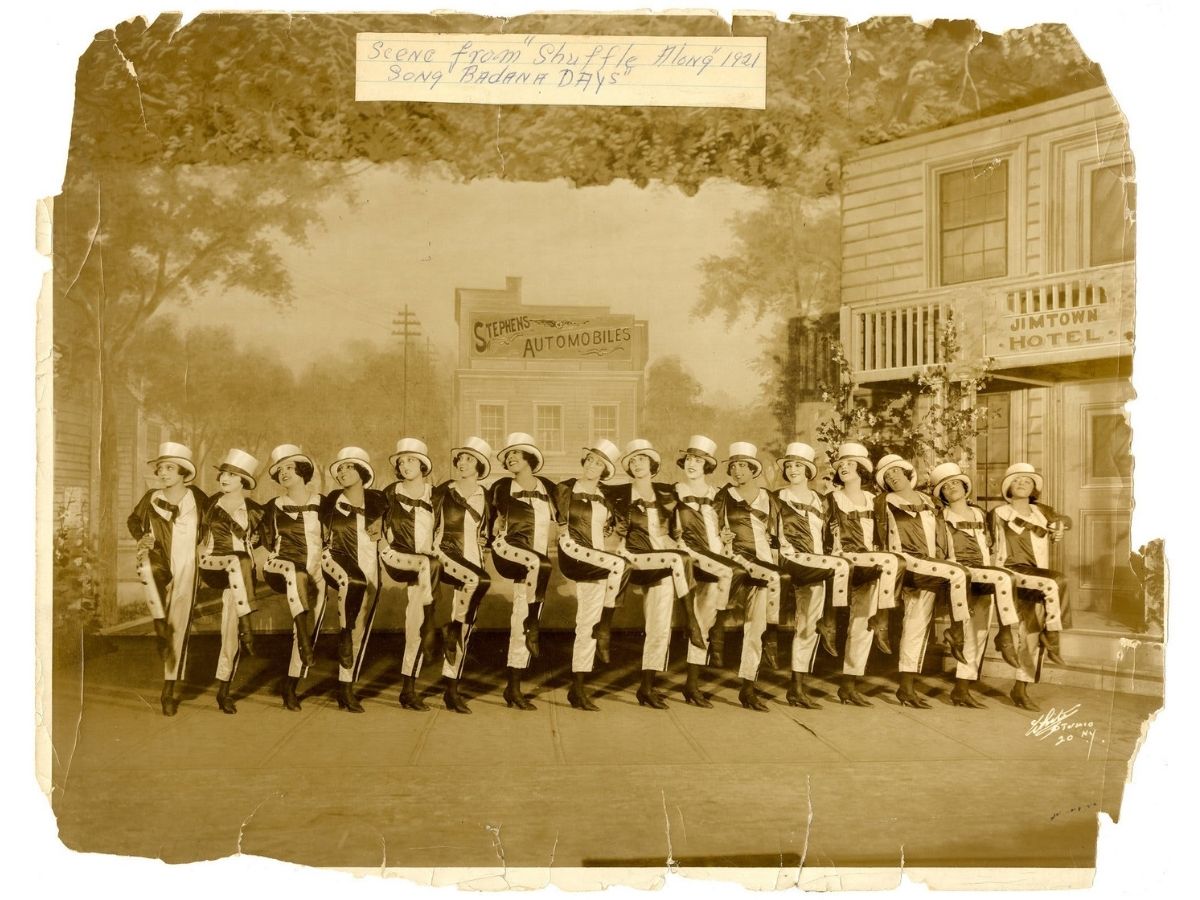Prof Cheryl Thompson and PhD candidate Emilie Jabouin on underexplored histories of Black performers
Cheryl Thompson (opens in new window) , scholar, Director of the Media Representation and Archives Lab (MRAL) at The Catalyst, and professor in the School of Performance recently published an article in the Journal of Communication Inquiry entitled Black Media Reporting on Theater, Dance, and Jazz Clubs in Canada: From Shuffle along to Rockhead’s Paradise (external link, opens in new window) co-written with Communication and Culture PhD candidate Emilie Jabouin (external link, opens in new window) (September 1, 2021). The research presents a way to recover the legacy of Black performing artists who made valuable contributions to the history of dance, music and culture in Canada and beyond.

Dancers in ‘‘Shuffle Along’’ performing ‘‘Bandanna Days.’’ Josephine Baker is sixth from the right. Photo courtesy of the Eubie Blake Photograph Collection/Maryland Historical Society
Significantly, Canada operated under de facto Jim Crow (1911–1954) segregation that while not legislated, remained in practice as the lived reality of Black Canadians at the time (as an important note, the Fair Accommodations Act made it formally illegal to discriminate in 1954 although segregation continued well beyond that time). The article’s central argument is that Canada’s Black newspapers played a pivotal role in promoting Black performance during a time when they were scarcely covered in the dominant media, a symptom of a broader culture of systemic racism and discrimination.
The very existence of a Black-run newspaper speaks to the resiliency of communities to tell their own stories and to celebrate the achievements of artists, dancers, and business owners

School of Performance Assistant Professor Cheryl Thompson

Communication and Culture PhD candidate Emilie Jabouin
“The very existence of a Black-run newspaper speaks to the resiliency of communities to tell their own stories and to celebrate the achievements of artists, dancers, and business owners at a time when there was no such promotion in the dominant culture,” asserts Thompson. “If these newspapers did not exist, we would not be in a position to recover these histories.”
How Black Canadian newspapers functioned as outlets for resistance
Canadian news coverage in the early twentieth century seldom mentioned Black Canadian dancers. By examining news coverage from the 1920s through 1950s of Black dance, musicals, and jazz clubs in Montreal, the authors explore three case studies to help recover the underexplored histories of Black performers and artists to deepen understanding of Black creative output and resistance during the period.
The case studies include Shuffle Along (1921–1924), the first all- Black Broadway musical to appear at Toronto’s Royal Alexandra Theatre, Alberta-born dancer Len Gibson (1926–2008), who revolutionized modern dance in Canada in the 1940s and 1950s, and the Montreal jazz club Rockhead’s Paradise (1928–1980), a pivotal site in the city’s Little Burgundy, a Black neighborhood that thrived in the 1930s through 1950s.
When Black people were excluded from or negatively portrayed in the dominant media, Thompson and Jabouin argue that it is within Canada’s Black press that we find celebratory reviews of collective achievement in ways that authenticate Black performance and help to debunk the myth of Black Canadians as newcomers. In contrast, these narratives support a community that has existed for generations, that has contributed in extensive ways to North American arts and culture and challenged dominant perceptions of Blackness.
“The contributions of Black performers in Canada but also the hardships and challenges faced by Black people due to pervasive anti-Black racism need to be told so that they are counted and situated as part of the Canadian narrative, not separate to it, or viewed as an ‘invading force’,” write the authors.
Celebrating Canada’s history of Black performance
Leonard “Len” Gibson (1926-2008), a Black Canadian dancer who was one of the first African Canadians to join The British Columbia Ballet Company played a significant role in the development of theatre and dance in Canada.
“Len Gibson is just one of dozens, possibly hundreds of Black performers who should be celebrated but either because so much time has passed since they performed and/or they have been written out of history we just don’t know them,” laments Thompson. “Many people are doing the work to collect the stories of these trailblazers and so I say there are a lot more Len Gibson’s out there than we think!”
“There is also a dissonance between identifying Black dancers as being Canadian just because as artists they had to pursue opportunities in the United States to succeed,” explains Jabouin. “So many times, people like Len Gibson, and the Crump Twins get erased as Canadian and are clumped into the idea of Black artists with the assumption that they are American.”
Another wonderful example of a Black production that has been omitted from dominant narratives of the history of Canadian performance include the touring performances of Shuffle Along (1921), one of the first-ever Broadway musicals produced by African Americans, which came to Toronto in 1923 and 1924 and has been credited with having a significant impact on the development of the Broadway musical, in particular those adapted with jazz music and Black dance.
“Shuffle Along was the first all-Black musical to perform on Broadway,” explains Thompson. “It was the first production where Black actors and dancers did not wear blackface nor did they act out racial caricatures of Blackness. The show revolutionized the stage with its innovative musical score filled with uptempo jazz numbers and slow love songs. The show’s creators, musician-songwriters Nobel Sissle and Eubie Blake were ahead of their time. It was not until the show was revived (external link, opens in new window) in 2016 that people really appreciated the significance of Shuffle Along to the history of Black storytelling in the theatre.”
The absence of research on Black performance in Canada
There exists a noticeable absence of research on or about Black performance in Canada. What is missing is a broader recognition of the influence and impact of African Americans and Black Canadians on performance and an understanding of the history of African-Canadian theatre.
“Many Black Canadian-born performers, like Len Gibson but also Eleanor Collins (external link, opens in new window) , who was just celebrated with a commemorative Canada Post Stamp, had to leave Canada and perform in the United States or they often shared the stage with known African American performers but we scarcely celebrate them as part of a transnational entertainment circuit,” asserts Thompson.

Commemorative Stamp of Eleanor Collins
News media today
Thompson, who was recently named to the Royal Society of Canada's College of New Scholars, believes Canadian media culture is improving, but more remains to be improved upon.
“Black performance is not additive to the Canadian story, it has been a central part of it from coast to coast for over a century”, shares Thompson. “The work that we, and so many others, are doing should really be called restorative. The media also has its restorative work to do to place Black Canadians honestly and accurately in our collective narrative.”
The Creative School at Ryerson University
The Creative School is a dynamic faculty that is making a difference in new, unexplored ways. Made up of Canada’s top professional schools and transdisciplinary hubs in media, communication, design and cultural industries, The Creative School offers students an unparalleled global experience in the heart of downtown Toronto.